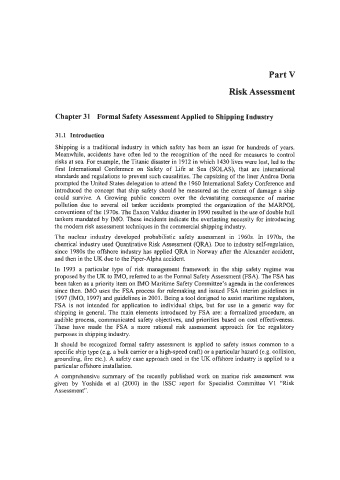Page 579 - Marine Structural Design
P. 579
Part V
Risk Assessment
Chapter 31 Formal Safety Assessment Applied to Shipping Industry
31.1 Introduction
Shipping is a traditional industry in which safety has been an issue for hundreds of years.
Meanwhile, accidents have often led to the recognition of the need for measures to control
risks at sea. For example, the Titanic disaster in 1912 in which 1430 lives were lost, led to the
first International Conference on Safety of Life at Sea (SOLAS), that are international
standards and regulations to prevent such causalities. The capsizing of the liner Andrea Doria
prompted the United States delegation to attend the 1960 International Safety Conference and
introduced the concept that ship safety should be measured as the extent of damage a ship
could survive. A Growing public concern over the devastating consequence of marine
pollution due to several oil tanker accidents prompted the organization of the MARPOL
conventions of the 1970s. The Exxon Valdez disaster in 1990 resulted in the use of double hull
tankers mandated by IMO. These incidents indicate the everlasting necessity for introducing
the modem risk assessment techniques in the commercial shipping industry.
The nuclear industry developed probabilistic safety assessment in 1960s. In 1970s, the
chemical industry used Quantitative Risk Assessment (QRA). Due to industry self-regulation,
since 1980s the offshore industry has applied QRA in Norway after the Alexander accident,
and then in the UK due to the Piper-Alpha accident.
In 1993 a particular type of risk management framework in the ship safety regime was
proposed by the UK to NO, referred to as the Formal Safety Assessment (FSA). The FSA has
been taken as a priority item on IMO Maritime Safety Committee’s agenda in the conferences
since then. IMO uses the FSA process for rulemaking and issued FSA interim guidelines in
1997 (IMO, 1997) and guidelines in 2001. Being a tool designed to assist maritime regulators,
FSA is not intended for application to individual ships, but for use in a generic way for
shipping in general. The main elements introduced by FSA are: a formalized procedure, an
audible process, communicated safety objectives, and priorities based on cost effectiveness.
These have made the FSA a more rational risk assessment approach for the regulatory
purposes in shipping industry.
It should be recognized formal safety assessment is applied to safety issues common to a
specific ship type (e.g. a bulk carrier or a high-speed craft) or a particular hazard (e.g. collision,
grounding, fire etc.). A safety case approach used in the UK offshore industry is applied to a
particular offshore installation.
A comprehensive summary of the recently published work on marine risk assessment was
given by Yoshida et a1 (2000) in the ISSC report for Specialist Committee V1 “Risk
Assessment”.

